Are you a Quiet Speculation member?
If not, now is a perfect time to join up! Our powerful tools, breaking-news analysis, and exclusive Discord channel will make sure you stay up to date and ahead of the curve.
Battle For Zendikar is finally live on Magic Online, which means two things. 1) I’m out of tickets, and 2) we can finally grind some matches with new updates!
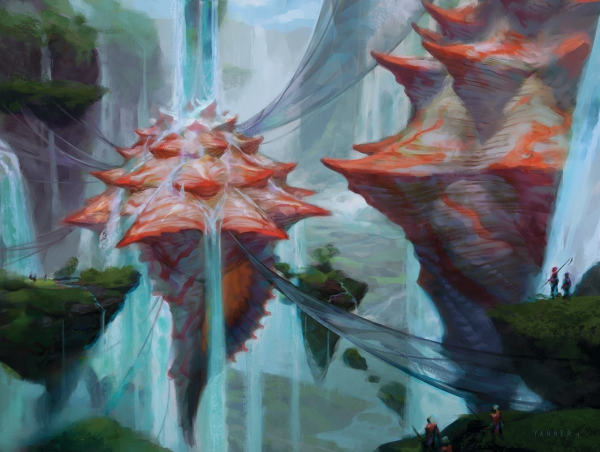
I’ve got a lot of things in the works, and expect some B/W Tokens and Bring to Light articles and videos coming soon, but for now there’s one deck I can’t stop playing. I give you Knightfall.
[wp_ad_camp_1]
"Knightfall - Trevor Holmes"
While I gave a brief introduction to the basic strategy here, today I wanted to take a more in-depth look at the archetype now that I’ve had the chance to test some actual games. While I am not yet a Knightfall expert, I have been able to test the deck a significant amount with some different configurations and have learned a few things. Let’s get started!
Overview
The combo of Knight of the Reliquary and Retreat to Coralhelm may be very powerful, but my take on the archetype aims to utilize each card effectively when I don’t have the combo. For those unaware, Retreat to Coralhelm with an active Knight of the Reliquary lets us burn through our deck, grabbing fetches for Forest/Plains to untap our Knight with Retreat and keep the chain going. The end result is a large attacking Knight of the Reliquary with access to protection from Sejiri Steppe (more on the intricacies of this combo below). While together they provide a fast combo capable of winning on turn three, what do these cards have to offer us individually, and how can we build to reinforce those strengths?
Knight of the Reliquary
 Besides being Brian Kibler’s favorite ever Magic card, what else does Knight of the Reliquary have going for it? For one, it’s a relatively cheap, hard-hitting threat that can apply the beats like any other fair man. A few fetchlands in the graveyard can see Knight up in the 4/4 or 5/5 range, putting it on pace or better than Loxodon Smiter for the same mana. Knight’s real power lies in her ability to tutor up any land and put it directly into play, assuming we have a Forest/Plains to feed it. This lets us find bullets like Ghost Quarter against Tron, Gavony Township on an anemic board, Sejiri Steppe to protect a creature, or Horizon Canopy if we need to draw cards. At its worst, Knight serves as a Birds of Paradise, letting us float a mana and then tutor up another land to function as a pseudo mana-elf.
Besides being Brian Kibler’s favorite ever Magic card, what else does Knight of the Reliquary have going for it? For one, it’s a relatively cheap, hard-hitting threat that can apply the beats like any other fair man. A few fetchlands in the graveyard can see Knight up in the 4/4 or 5/5 range, putting it on pace or better than Loxodon Smiter for the same mana. Knight’s real power lies in her ability to tutor up any land and put it directly into play, assuming we have a Forest/Plains to feed it. This lets us find bullets like Ghost Quarter against Tron, Gavony Township on an anemic board, Sejiri Steppe to protect a creature, or Horizon Canopy if we need to draw cards. At its worst, Knight serves as a Birds of Paradise, letting us float a mana and then tutor up another land to function as a pseudo mana-elf.
Retreat to Coralhelm
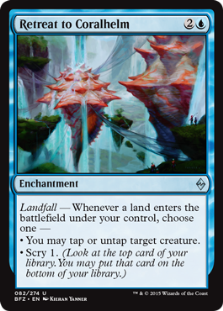 While definitely not on the level of Knight of the Reliquary, Retreat to Coralhelm provides just enough value that it’s not an entirely blank combo piece on its own (unlike Splinter Twin). Tapping down blockers with every landfall trigger can really help us push damage past a clogged board, and can even be used defensively (against Twin, for example) if we hold fetchlands to sacrifice on our opponent's turn. Scry 1 might seem minor, but anyone with experience playing Temples in the previous Standard format can speak to how deceptively powerful that ability can be. This effect is compounded by the ramped-up card quality in Modern, as less lands and more powerful effects translate into more value for scry (just look at UR Thopters from Pro Tour Vancouver). While we would never play Retreat to Coralhelm on its own in Modern, we can still work to take advantage of its abilities by focusing on compounding its tempo-generating tap ability.
While definitely not on the level of Knight of the Reliquary, Retreat to Coralhelm provides just enough value that it’s not an entirely blank combo piece on its own (unlike Splinter Twin). Tapping down blockers with every landfall trigger can really help us push damage past a clogged board, and can even be used defensively (against Twin, for example) if we hold fetchlands to sacrifice on our opponent's turn. Scry 1 might seem minor, but anyone with experience playing Temples in the previous Standard format can speak to how deceptively powerful that ability can be. This effect is compounded by the ramped-up card quality in Modern, as less lands and more powerful effects translate into more value for scry (just look at UR Thopters from Pro Tour Vancouver). While we would never play Retreat to Coralhelm on its own in Modern, we can still work to take advantage of its abilities by focusing on compounding its tempo-generating tap ability.
Process
With these characteristics in mind, we can start to think about the shell we’d like to build around Retreat to Coralhelm and Knight of the Reliquary. Remember, our goal is to craft a strategy that can  take advantage of either card’s unique abilities without requiring both to win. Otherwise, we are just another clunky two-card combo deck and should probably be playing Splinter Twin. So, starting at the bottom, we have two sorcery speed three-drops, one costing 2U and the other 1GW. This automatically suggests Bant, or at least G/W/u. While we could splash for a fourth (or fifth) color, keeping our mana requirements as simple as possible will let us play more colorless bullet lands for Knight of the Reliquary. Bant has access to two excellent mana creatures in the form of Birds of Paradise and Noble Hierarch, which will help us accelerate out three-drops as early as turn two, and even contribute to attacking in Noble Hierarch’s case.
take advantage of either card’s unique abilities without requiring both to win. Otherwise, we are just another clunky two-card combo deck and should probably be playing Splinter Twin. So, starting at the bottom, we have two sorcery speed three-drops, one costing 2U and the other 1GW. This automatically suggests Bant, or at least G/W/u. While we could splash for a fourth (or fifth) color, keeping our mana requirements as simple as possible will let us play more colorless bullet lands for Knight of the Reliquary. Bant has access to two excellent mana creatures in the form of Birds of Paradise and Noble Hierarch, which will help us accelerate out three-drops as early as turn two, and even contribute to attacking in Noble Hierarch’s case.
Mana
Decks with mana creatures tend to want less lands to reduce the risk of flooding, and I always like playing Gavony Township alongside cheap mana guys if possible. While we could play eight or even nine mana guys, I tend to prefer seven as a solid starting point. Any more than that and we start to get flooded often, and I don’t anticipate playing many spells that cost more than three. For our manabase, we should be looking to play 21 or 22 lands, and we have to make sure we have enough Forest/Plains to grow Knight up to one-shot range. Remember that each Forest/Plains can contribute two points of power to Knight, as we will tutor up fetches and then go get another Forest/Plainsto keep going (and get extra Retreat triggers as well). A 9-7 split on basics/fetches with five “bullets” should give us the ability to one-shot our opponent and fit some spicy stuff in as well. At this point I think it’s a good idea to look at where we’re at, because from here the deckbuilding decisions become a little murkier and branch out.
"Core Cards"
This gives us 15 spells and 19 lands, leaving us two land spots and 24 spell slots to fill. Any green deck looking to attack with creatures needs a big reason to not play Tarmogoyf, and besides price I can’t think of one, so he’s in. Other than that, we aren’t “forced” to play anything, so I want to slow down and explore our options, talking about some concepts before we start adding to the list again.
Identity – What are we trying to do?
When working on a new archetype, the first thing I look to for guidance is context (shocker, I know). Those familiar with my articles have heard me speak of context time and again, and until I hear complaints I will probably continue to do so. When I refer to context, I’m talking about the collective environmental factors that influence the state of Magic as we see it today. Burn as a major format player, Splinter Twin as a punisher for non-interaction, Blood Moon as a safeguard for crazy manabases, Tarmogoyf as a ubiquitous threat; all of these and more contribute to this notion of “context” that many refer to as the metagame. Whether your realize it or not, our card evaluation process always involves one or more of these factors: “I can’t play 4 Dismember because of Burn”…”5 Color sounds sweet, but how do you handle Blood Moon?”…”Nicol Bolas, Planeswalker is the man, but dude…” Context can be carried further, however, and it’s important to remember “identity”, or what this archetype is doing that is unique to itself. Merfolk exists as a strong, linear deck that punishes blue decks and can grind out opponents relying on one-for-one removal. This elevates it above the teeming masses of Sliver Aggro, Allies, Vampires, Goblin Tribal, Zoo, etc because while each of these decks does something slightly different, at their core they are just a worse Merfolk deck. Now sure, there is value in playing a similar strategy that attacks the field from a different angle (ex: playing Zoo when Merfolk hate is prevalent) but if you can’t easily answer the question “Why aren’t you just playing X” then maybe you should just play X.
When I refer to context, I’m talking about the collective environmental factors that influence the state of Magic as we see it today. Burn as a major format player, Splinter Twin as a punisher for non-interaction, Blood Moon as a safeguard for crazy manabases, Tarmogoyf as a ubiquitous threat; all of these and more contribute to this notion of “context” that many refer to as the metagame. Whether your realize it or not, our card evaluation process always involves one or more of these factors: “I can’t play 4 Dismember because of Burn”…”5 Color sounds sweet, but how do you handle Blood Moon?”…”Nicol Bolas, Planeswalker is the man, but dude…” Context can be carried further, however, and it’s important to remember “identity”, or what this archetype is doing that is unique to itself. Merfolk exists as a strong, linear deck that punishes blue decks and can grind out opponents relying on one-for-one removal. This elevates it above the teeming masses of Sliver Aggro, Allies, Vampires, Goblin Tribal, Zoo, etc because while each of these decks does something slightly different, at their core they are just a worse Merfolk deck. Now sure, there is value in playing a similar strategy that attacks the field from a different angle (ex: playing Zoo when Merfolk hate is prevalent) but if you can’t easily answer the question “Why aren’t you just playing X” then maybe you should just play X.
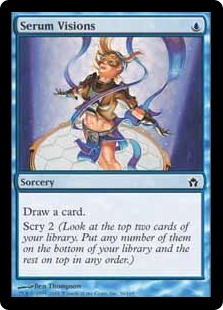 I say all that to observe this; we have to be careful of where we sit on the archetype spectrum. Adding Serum Visions and Mana Leak to our deck might be right, but at that point we start to do a lot of the things that Twin can do better, and I find that worrisome. On the other end of the spectrum, we could go all-in on aggro, playing Delver of Secrets and Vapor Snag and end up with an incohesive strategy where our combo is out of place. For me, Retreat to Coralhelm’s tap ability and Knight of the Reliquary’s aggressive sizing suggests a close fit alongside cards that help to generate and push tempo. Our identity, if we were to label it, should be something along the lines of aggro-tempo with a combo element.
I say all that to observe this; we have to be careful of where we sit on the archetype spectrum. Adding Serum Visions and Mana Leak to our deck might be right, but at that point we start to do a lot of the things that Twin can do better, and I find that worrisome. On the other end of the spectrum, we could go all-in on aggro, playing Delver of Secrets and Vapor Snag and end up with an incohesive strategy where our combo is out of place. For me, Retreat to Coralhelm’s tap ability and Knight of the Reliquary’s aggressive sizing suggests a close fit alongside cards that help to generate and push tempo. Our identity, if we were to label it, should be something along the lines of aggro-tempo with a combo element.
Filling out the Deck
Voice of Resurgence functions as not only the second best two drop in our colors, but works well with our combo elements.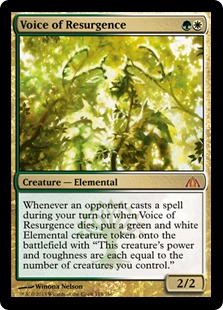 Discouraging use of both counterspells and instant speed removal, Voice of Resurgence often functions as a pseudo-Grand Abolisher by forcing our opponents into using mana on their own turn. Unsuspecting players will often look to maximize mana efficiency in the face of a Voice of Resurgence by powering out threats where they would otherwise leave up removal/countermagic, paving the way for us to execute our combo. The mere threat of free Elemental tokens is often enough to discourage our opponents from interacting with us at instant speed, which is exactly where we want to be. Even Voice’s fail-state (dying to Lightning Bolt) still leaves an Elemental behind and helps clear the way for Knight to live later.
Discouraging use of both counterspells and instant speed removal, Voice of Resurgence often functions as a pseudo-Grand Abolisher by forcing our opponents into using mana on their own turn. Unsuspecting players will often look to maximize mana efficiency in the face of a Voice of Resurgence by powering out threats where they would otherwise leave up removal/countermagic, paving the way for us to execute our combo. The mere threat of free Elemental tokens is often enough to discourage our opponents from interacting with us at instant speed, which is exactly where we want to be. Even Voice’s fail-state (dying to Lightning Bolt) still leaves an Elemental behind and helps clear the way for Knight to live later.
With a stable tap effect in the form of Retreat to Coralhelm, Geist of Saint Traft starts to look very appealing. One of the most powerful three mana-creatures that doesn’t see much play, Geist has always been held back by ever-present blockers threatening to get in his way. The two card combo of Geist/Retreat may not win the game on the spot like Knight of the Reliquary, but rest assured that two turns of tapping down blockers gets the job done just as well. Alongside seven mana-dorks, Geist of Saint Traft can often come down a full turn earlier than normal, which can be devastating against many opponents.
Due to the prevalence of fast aggro, mana creatures, and creature-based combo, almost every deck in the format that isn’t all-in combo needs some form of interaction. This often takes the form of counterspells, removal, or both. In our colors, removal means either Path to Exile or Vapor Snag.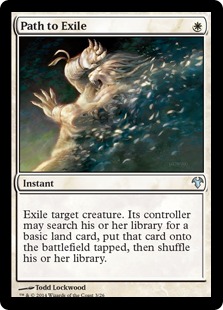 I like playing the full set of Path to Exile here, as it is the stronger spell, lets us keep our blue to a relatively light splash, and we often don’t mind giving our opponent a free land. Killing a creature cheaply and efficiently, no questions asked, is what we’re in the market for, and Path to Exile delivers. In this same vein, Remand works to buy time and gives us a broad answer to all sorts of threats, be they Tarmogoyf, Mana Leak, or Splinter Twin. As long as we’re presenting a clock or forcing through our combo, the “card disadvantage” associated with Remand giving our opponent back their spell is often irrelevant, as we are usually too far ahead on tempo for this to matter.
I like playing the full set of Path to Exile here, as it is the stronger spell, lets us keep our blue to a relatively light splash, and we often don’t mind giving our opponent a free land. Killing a creature cheaply and efficiently, no questions asked, is what we’re in the market for, and Path to Exile delivers. In this same vein, Remand works to buy time and gives us a broad answer to all sorts of threats, be they Tarmogoyf, Mana Leak, or Splinter Twin. As long as we’re presenting a clock or forcing through our combo, the “card disadvantage” associated with Remand giving our opponent back their spell is often irrelevant, as we are usually too far ahead on tempo for this to matter.
Once we start heading down the path of playing spells like Remand, I really want to be sure we will be able to take advantage of the tempo-generating effect it provides. Remanding a spell while we aren’t capitalizing with free attacks is a "spinning tires" 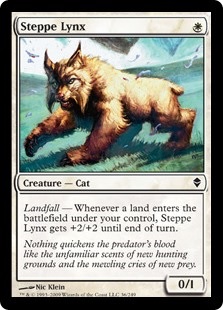 feeling I would like to avoid, which leads me to wanting more early drops. While we have a plethora of two-drops available to us, our identity as a landfall deck along with our seven fetchlands really makes me want to try Steppe Lynx. Having a second creature out that can go huge with Knight of the Reliquary burning through land drops is great, but I’m more excited for what 11 one drops does for our consistency. While it can sometimes be awkward to have both mana creatures and Steppe Lynx in hand on turn one, the ability to always have something to do on the first turn of every game is not to be undervalued, and goes a long way towards pushing that tempo effect we’ve talked about so much. Again, even if Steppe Lynx eats a Lightning Bolt, that is one less removal spell our opponent is aiming at our Knight of the Reliquary, and the ceiling on Steppe Lynx is huge. Go on, attack with Steppe Lynx for eight damage over two turns and tell me you’re not having fun!
feeling I would like to avoid, which leads me to wanting more early drops. While we have a plethora of two-drops available to us, our identity as a landfall deck along with our seven fetchlands really makes me want to try Steppe Lynx. Having a second creature out that can go huge with Knight of the Reliquary burning through land drops is great, but I’m more excited for what 11 one drops does for our consistency. While it can sometimes be awkward to have both mana creatures and Steppe Lynx in hand on turn one, the ability to always have something to do on the first turn of every game is not to be undervalued, and goes a long way towards pushing that tempo effect we’ve talked about so much. Again, even if Steppe Lynx eats a Lightning Bolt, that is one less removal spell our opponent is aiming at our Knight of the Reliquary, and the ceiling on Steppe Lynx is huge. Go on, attack with Steppe Lynx for eight damage over two turns and tell me you’re not having fun!
"Maindeck"
Sideboard
The final numbers are still up in the air, but this is the basic thought process I used to arrive at the list I outlined at the beginning of the article. So you don’t have to scroll up, here is where I’m at before we move on to the sideboard. I am currently trying two Loxodon Smiter in place of the fourth Remand and Voice of Resurgence and have been liking them so far, but there is definitely some wiggle room in the maindeck. I could see anything from a fifth removal spell to a Dispel or even a Spellskite depending on the metagame and our exact configuration. Rather than just hand you a 15 card sideboard, I’d like to briefly go over some spells I chose and let you explore with me what we should be preparing for.
Kitchen Finks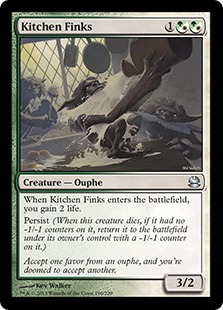 is one of the best cards legal in Modern without a great home. Great against aggro, midrange, and control, Kitchen Finks punishes one-for-one removal and even goes nicely with our Gavony Township. A must include for any archetype looking for help against Burn or Jund.
is one of the best cards legal in Modern without a great home. Great against aggro, midrange, and control, Kitchen Finks punishes one-for-one removal and even goes nicely with our Gavony Township. A must include for any archetype looking for help against Burn or Jund.
Dispel is the best blue card in Modern, maybe tied with Snapcaster Mage, and directly supports our plan of attacking with cheap creatures and protecting said creatures cheaply. I would definitely like to find room for three, but I’ve been playing two.
Feed the Clan is really only for Burn, but it's excellent against them. Five life ends up being around 1.5 cards, and we have multiple creatures to enable ferocious. If we ever cast this for 10 life it’s very difficult to lose. We might be fine without it against Burn, but it’s never wrong to play it safe.
Spellskite is the ever-present catch-all answer for Modern, and you can find a use for it post-board in pretty much every matchup. A great protection effect that doubles as disruption against Twin, Infect, and Bogles, there’s a reason why Spellskite is played so much in Modern.
Stony Silence is one of the best, if not the best, answer for Affinity that also does work against Tron. An auto-include at this point for any Modern deck with access to white mana.
Aven Mindcensor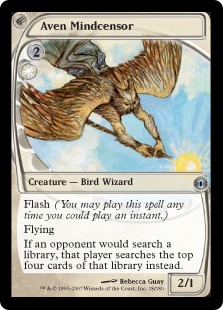 is a solid role-player against Tron that does good work against Scapeshift and Amulet as well. I’ve found some difficulty with the Tron matchup and I’ve liked the 2/1 flying body too, but Mindcensor could definitely be anything else if you need the room.
is a solid role-player against Tron that does good work against Scapeshift and Amulet as well. I’ve found some difficulty with the Tron matchup and I’ve liked the 2/1 flying body too, but Mindcensor could definitely be anything else if you need the room.
Dismember is another solid catch-all removal spell for when we need a fifth or sixth piece of creature-kill. As always, Dismember provides access to removal that can kill a Goblin Guide, Deceiver Exarch, Tarmogoyf or Gurmag Angler for one mana in colors that are not black. If you need more removal, Dismember is probably second best after Path to Exile.
Crucible of Worlds is a fun bullet against Tron that has, in my opinion, done a lot of work to make a poor matchup much more manageable. Rebuying Ghost Quarters is the dream, and has been a solid way to attack the matchup in my experience.
Deprive is a great no-questions-asked counterspell for when we need such a thing, and it can serve as either the fifth Remand or a slightly slower, much more versatile Dispel in matchups where we are looking to go a little more reactive.
Conclusion
Currently, that is where I’m at regarding Knightfall in Modern! While I’ve had a fair amount of experience with the deck in a variety of matchups, the sideboard and maindeck have both been in flux to the point where I can’t speak with complete clarity regarding positive/negative win rates and exact sideboard configurations. As is always the case with an unexplored archetype, the amount of work that goes into tuning/preparing the deck against established, well-oiled machines can be daunting, but the results can be rewarding.
I hope you enjoyed this look inside my process for building Knightfall, and if you have any thoughts/opinions/suggestions feel free to let me know in the comments below! As always, stop by my stream at twitch.tv/Architect_Gaming if you want to see this deck in action! I’ll see you there.
Trevor Holmes
The_Architect on MTGO
Twitch.tv/Architect_Gaming
Twitter.com/7he4rchitect





Have you tried lotus cobra and/or swords? Collected Company? Those are the standout alternatives that I’ve seen. I’ve also seen props for courser of kruphix since paired with retreat its a lot of control over your draws (and bonus points for courser being hit by company and being a t2 play off a dork).
I don’t love steppe lynx here – I’ve seen it run in zoo decks before and invariably it ends up costing them the game where a loam lion would have won it. It has a place in temur battle rage decks because doubling 4 is a big deal, but otherwise I don’t feel this card is correct to play in modern given the plethora of alternatives.
Cobra synergizes with a high fetch count, but you need ways to leverage the mana – which swords seem to do quite nicely.
Lotus Cobra has always suffered from giving us the mana a turn after we really need it (as T1 acceleration is miles better than T2 acceleration). It’s true that Cobra gives us a bunch of mana and plays well with our fetches, but on Turn 2 I’m looking to cast three drops and start attacking from there.
Collected Company has been on my mind and were I to cut some of the Remands/Path to Exile I could definitely see playing some. As of now my spell count seems a little too high.
Green-white decks I saw on the field use cards like Collected Company, Chord of Calling and Eternal Witness to make sure they can get back into game and topdeck nicely. This makes them not splash red to have reasonable reach as they can easily clog the board again. Should even Retreat deck player be worried in such a things at all or it’s more like all in type of strategy? Sure, if you scroll down all your lands in deck, you probably always draw something useful, but still. Or I just look at that deck from wrong perspective, trying to put it into some sort of grindy creature based deck category?
I can’t help but feel that this wants 1-2 Bant Charm
also simic charm is some jordan boisvert tech that might be useable in knightfall. the rarely used hexproof mode can save your retreat (or sword) from removal. The bounce is always versatile, and while the +3+3 isn’t as good as it is with mandrils, it provides some reach and can be solid when you upgrade your geist to kill a blocking tasigur/goyf
Definitely seems interesting!
Scooze didn’t make it?
Hey Trevor! Just looking for some assistance here for the current metagame and your thoughts on how it will move going forward. Why, in your opinion, is the Grixis Control deck not seeing very much play? Also, do you think that the deck is going to become a top contender again after we get back into the modern season? If not, do you think the Blue Jund lists and the Grixis Delver lists are becoming the superior versions of the deck? I personally play delver and I am looking to branch out further into the control list, but looking online it seems to have put up little to no results over the past month or so.
It just seems to me like everyone is prepared for Grixis now. Every match is an uphill battle as nobody is falling over to a Gurmag Angler anymore, and I often find myself losing games by inches with that deck. I still think the deck is excellent, it’s just possible that we need to evolve it in a slightly different direction.
I Just playing this.
4 path
2 dromoka
1 dispel
2 collected.
3 retreat to coralhem
4 noble hierach
2 birds
1 spellskite
3 geist of sant craft
4 knight of relicary
4 tarmogoyf
3 voices
3 qasali pridemage
1 ojutai dragonlord
1 courser of kruphix
1 batterskull
21land not fewer..
1 gavony
1 steppe
1 rogue passage.
4 windspeth
4 misty
1 flooded
1 hallowed
1 temple garden
1 canopy vista
1 horizon canopy
1 u/w tango
1 breeding pool
2 forest
1 plains
Side:
1Dromoka dl
1Primeval titan
3 meedling mage
1 scooze
1 vendilion
1 spellskite
2 relic of progenitus
1 aven mindcensor
1 Fracturing gust
1 simic charm ( semms good in main) but only if they cut the retreats is really good.
1 thrastrusk
1 Valorous stance.